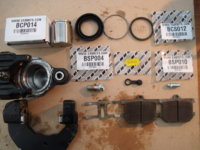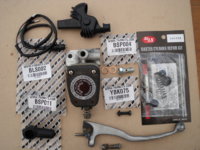There's a fairly new chain/sprocket set on it and the PO (or whoever fitted it) hadn't the proper tools - chisel gouges on the nut - and it had loosened off. It was actually spinning loose and only the slight bend on the washer had stopped it coming off. I find it amazing that someone could have left it like that. If they had a chisel they could have at least used it to bend the washer up properly.
Close inspection of the sprocket area seems to show the oil seal there is ok, all the oil around there is coming from fling-off from the Scottoiler.
Hi Grimly,
perhaps the nut seemed tight when the PO chiseled it on?
There seems to be no middle ground with that nut.
I've spun one of mine off by hand after I'd tightened it with a socket and breaker bar.
OTOH, the one I tightened with an air impact wrench needed one to get it off again.
And yeah, a Scottoiler can get over-enthusiastic if it's set to maximum but the bog-pan sealant comment was about the chain looking like it was smeared with shite.


 Get yourself some of that gorgeous yamaha liquid gasket Neo 1104 Three Bond . I've never seen it as cheap as it is at the moment .£6.00
Get yourself some of that gorgeous yamaha liquid gasket Neo 1104 Three Bond . I've never seen it as cheap as it is at the moment .£6.00 

 With the added potential for silicon to block small critical oilways I cannot see any advantage in using silicon except that it is usually less than half the price.
With the added potential for silicon to block small critical oilways I cannot see any advantage in using silicon except that it is usually less than half the price.